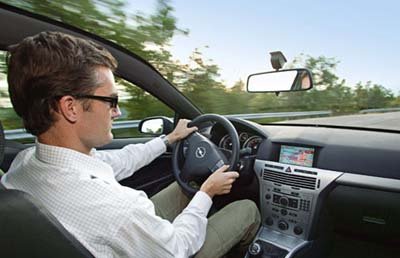Opel Astra “Panoramic”
Last Updated:


If the Saturn version of the Astra turns out to be close to the Opel one, I can’t really see anyone considering a Chevy Cobalt over the Saturn.
It would be great to have that Panoramic Option as well, but I ‘m not holding my breath…

Some cars in the 1950s had windshields that extended into the roof. That made it easy to see overhead traffic lights, but there was too much glare from the sun on bright days and the gimmick was quickly dropped.
Unless the upper part of the glass is heavily tinted, this could be annoying on sunny days.
notice the guy is wearing sunglasses =).. seems pretty cool though
Wouldn’t feel too safe in that in an accident or otherwise. That’s a lot of glass shattering on you if a tree branch or something falls down.
WILL SOMEONE PLEASE THINK OF THE REPAIR COSTS!!!
oven on wheels if you ask me… think how hot it will get if you park your car in a sunny area.
Only flying is better – you experience your surroundings just like in the cockpit of an airplane because there is no crossbeam restricting the view,” explains Matthias Hallik, responsible for new body concepts at Opel, who had the initial idea for the panorama windshield. “This makes driving through mountains or a brightly lit city at night, for example, a really special experience.” GTC passengers enjoy these views thanks to a 1.50 meter long and, on average, 1.16 meter wide field of vision made of Solar-Protect glass, which prevents over-heating of the interior. The panorama windshield is also an eye-catcher from outside, as it flows into the adjacent steel roof, creating a visually integrated surface.
Numerous crash simulations and real tests show that the panorama windshield in no way impairs safety or stability. All results confirm that there are no noteworthy differences to the steel roof three-door model, thanks to the GTC’s rigid A and B-pillars, an additional crossmember in the middle of the roof and the sturdy floor assembly. All tests regarding body rigidity had similar positive results.
Stable passenger cell construction and high panorama glass stability are the major contributing factors to these good results. This model-variant only weighs around 10 kilograms more than the Astra GTC with a standard windshield. The arched panorama windshield, made of six-millimeter thick, laminated safety glass, is shaped by means of a gravity bending process. Selected points on the glass pane are heated so strongly in a special oven that gravitational force alone pulls it into a predefined form – a very elaborate process with glass of this strength and size (around 1.8 m2).
Passengers in the panorama GTC are protected against excessive sunlight by both the Solar-Protect glass and a sophisticated shading system. The stepless adjustable system is very easy to operate and includes two fold-out sun visors.
The Opel Astra GTC – the third model in the new Astra generation after the five-door sedan and the station wagon – will be manufactured from next year in Antwerp, Belgium. Beginning in April 2005, the innovative panorama windshield will also be built into the cars there. A patent application for the entire panorama windshield design concept has been submitted
Thanks for all that info.
Cool, but no thanks. Keeping my sunvisors for now (which I see are missing for obvious reasons). I’d have a headache from squinting all day in this car.
Having said that, I hope Saturn gets this baby. It’s the sort of pizzaz (along with the sexy Sky) they so desperately need. The Sky is a fantastic first start. Let’s hope they don’t drop the ball like they’ve done before.
Turkeys, perhaps the glass is tinted to prevent glare and other types of distractions that might interfer with driving.
The Germans know what they are doing when it comes to smartness.
Perhaps you are wrong.
that guy looks like a kraut.
the car looks like a middle age men with his hair line moved up. lol
no sun visor would suck as well. unless they come with removable sun visor using suction cup
Look closely at this picture (hope the link works right)It looks like they’ve built in a forward sliding cover (like those on sunroofs) that would cover the extended part of the windwhield. Looks like it has sun visors on it, too. :)Make it a Saturn!